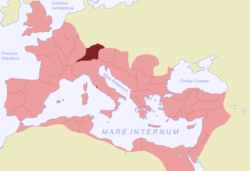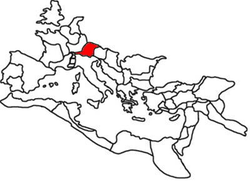Raetia
| Provincia Raetia | |||||
| Province of the Roman Empire | |||||
| |||||
 | |||||
| Capital | Augusta Vindelicorum | ||||
| Historical era | Antiquity | ||||
| - | Established | 15 | |||
| - | Ostrogoth conquest | 476 | |||
| Today part of | | ||||


Raetia (so always in inscriptions; classical manuscripts usually use the form Rhaetia; /ˈriːʃə/ or /ˈriːʃiə/) was a province of the Roman Empire, named after the Rhaetian (Raeti or Rhaeti) people. It was bounded on the west by the country of the Helvetii, on the east by Noricum, on the north by Vindelicia, on the west by Cisalpine Gaul and on south by Venetia et Histria. It thus comprised the districts occupied in modern times by eastern and central Switzerland (containing the Upper Rhine and Lake Constance), southern Bavaria and the Upper Swabia, Vorarlberg, the greater part of Tirol, and part of Lombardy. Later Vindelicia, today south eastern Wuerttemberg and south western Bavaria was forming part of Raetia. The northern border of Raetia during the times of Augustus and Tiberius was the River Danube. Later the northern boundary was formed by the Limes Germanicus, stretching for 166 km north of the Danube. Raetia was linked to Italy across the Alps over the Reschen Pass, by the Via Claudia Augusta.
History
Little is known of the origin or history of the Raetians, who appear in the records as one of the most powerful and warlike of the Alpine tribes. Livy states distinctly[1] that they were of Etruscan origin (a belief that is favored by Niebuhr and Mommsen). A tradition reported by Justin[2] and Pliny the Elder[3] affirmed that they were a portion of that people who had settled in the plains of the Po and were driven into the mountains by the invading Gauls, when they assumed the name of "Raetians" from an eponymous leader Raetus; a more probable derivation, however, is from Celtic rait ("mountain land"). Even if their Etruscan origin be accepted, at the time when the land became known to the Romans, Celtic tribes were already in possession of it and had amalgamated so completely with the original inhabitants that, generally speaking, the Raetians of later times may be regarded as a Celtic people, although non-Celtic tribes (es. Euganei) were settled among them.
The Raetians are first mentioned (but only incidentally) by Polybius,[4] and little is heard of them till after the end of the Republic. There is little doubt, however, that they retained their independence until their subjugation in 15 BC by Tiberius and Drusus.[5]
At first Raetia formed a distinct province, but towards the end of the 1st century AD Vindelicia was added to it; hence Tacitus (Germania, 41) could speak of Augusta Vindelicorum (Augsburg) as "a colony of the province of Raetia". The whole province (including Vindelicia) was at first under a military prefect, then under a procurator; it had no standing army quartered in it but relied on its own native troops and militia for protection until the 2nd century AD.
During the reign of Marcus Aurelius, Raetia was governed by the commander of the Legio III Italica, which was based in Castra Regina (Regensburg) by 179 AD . Under Diocletian, Raetia formed part of the diocese of the vicarius Italiae, and was subdivided into Raetia prima, with a praeses at Curia Raetorum (Chur) and Raetia secunda, with a praeses at Augusta Vindelicorum (Augsburg), the former corresponding to the old Raetia, the latter to Vindelicia. The boundary between them is not clearly defined, but may be stated generally as a line drawn eastwards from the lacus Brigantinus (Lake Constance) to the Oenus (River Inn).
During the last years of the Western Roman Empire, the land was in a desolate condition, but its occupation by the Ostrogoths in the time of Theodoric the Great, who placed it under a dux, to some extent revived its prosperity.
Economy
The land was very mountainous, and the inhabitants, when not engaged in predatory expeditions, chiefly supported themselves by breeding cattle and cutting timber, little attention being paid to agriculture. Some of the valleys, however, were rich and fertile, and produced wine, which was considered equal to any in Italia. Augustus Caesar preferred Raetian wine to any other. Considerable trade in pitch, honey, wax, and cheese occurred.
Human geography
The chief towns of Raetia (excluding Vindelicia) were Tridentum (Trento) and Curia (Coire or Chur). It was traversed by two great lines of Roman roads — the Via Claudia Augusta leading from Verona and Tridentum across the Reschen Pass to the Fern Pass and thence to Augusta Vindelicorum (Augsburg),[6] the other from Brigantium (Bregenz) on Lake Constance by Chur and Chiavenna to Como and Milan.
County of Raetia (Rätien)
Charlemagne raised the district that was still governed under Frankish rule by a praeses in the 8th century to a county of Raetia, with a reminiscence of its Roman divisions in the name Reciarum comes, "count of the Raetias", as late as 807; it was absorbed into the duchy of Swabia at the beginning of the 10th century.[7]
In the mid-8th century a surviving Lex Romana Curiensis, a "Roman Law of Chur", was an abbreviated epitome of the Breviary of Alaric. Under the Roman trappings of iudex provincialis or defensor civitatis, the historian of early medieval Raetia, Elizabeth Meyer-Marthaler, recognized the public officials common throughout the Frankish empire. Not much later, the power of the comes was invested in the bishop of Chur; this experiment was brought to an end when Hunfrid, Margrave of Istria, was made count of Raetia in 807. With this as a power base, his Hunfriding heirs were able to gather enough power that Burchard II (919-926) was able to make himself duke of Swabia, and Raetia herceforward lost its separate identity.[8]
The Rätikon mountain range derives its name from Raetia.
Important cities
- Alae (Aalen)
- Arbor Felix (Arbon)
- Apodiacum (Epfach)
- Aquilea (Heidenheim an der Brenz)
- Augusta Vindelicorum (Augsburg)
- Ausugum (Borgo Valsugana)
- Bauzanum or Pons Drusi (Bolzano)
- Belunum (Belluno)
- Bilitio (Bellinzona)
- Brigantium (Bregenz)
- Cambodunum (Kempten im Allgäu)
- Castra Batava (Passau)
- Castra Regina (Regensburg)
- Clavenna (Chiavenna)
- Clunia (probably Feldkirch or Balzers)
- Curia (Chur)
- Endidae (Neumarkt)
- Feltria (Feltre)
- Foetes (Füssen)
- Guntia (Günzburg)
- Gamundia Romana (Schwäbisch Gmünd)
- Oscela (Domodossola)
- Parthanum (Partenkirchen)
- Sebatum (San Lorenzo di Sebato/St. Lorenzen)
- Sorviodurum (Straubing)
- Sublavio (Ponte Gardena/Waidbruck)
- Tridentum (Trento)
- Veldidena (Wilten district of Innsbruck)
- Vipitenum (Vipiteno/Sterzing)
See also
References
Sources
 This article incorporates text from a publication now in the public domain: Chisholm, Hugh, ed. (1911). "Raetia". Encyclopædia Britannica 22 (11th ed.). Cambridge University Press. pp. 812–813
This article incorporates text from a publication now in the public domain: Chisholm, Hugh, ed. (1911). "Raetia". Encyclopædia Britannica 22 (11th ed.). Cambridge University Press. pp. 812–813
Further reading
- PC von Planta, Das alte Rätien (Berlin, 1872)
- T Mommsen in Corpus Inscriptionum Latinarum, iii. p. 706
- Joachim Marquardt, Römische Staatsverwaltung, 1. (2nd ed., 1881) p. 288
- Ludwig Steub, Ueber die Urbewohner Rätiens und ihren Zusammenhang mit den Etruskern (Munich, 1843)
- Julius Jung, Römer und Romanen in den Donauländern (Innsbruck, 1877)
- Smith's Dictionary of Greek and Roman Geography (1873)
- T Mommsen, The Roman Provinces (English translation, 1886), i. pp. 16, 161, 196
- Mary B Peaks, The General Civil and Military Administration of Noricum and Raetia (Chicago, 1907).
External links
- Bagnall, R., J. Drinkwater, A. Esmonde-Cleary, W. Harris, R. Knapp, S. Mitchell, S. Parker, C. Wells, J. Wilkes, R. Talbert, M. E. Downs, M. Joann McDaniel, B. Z. Lund, T. Elliott, S. Gillies. "Places: 991348 (Raetia)". Pleiades. Retrieved March 8, 2012.
| ||||||||||||||||||||||||||||||||||||||||||||||||||||||||||||||||||||||||||||||||||||||||
